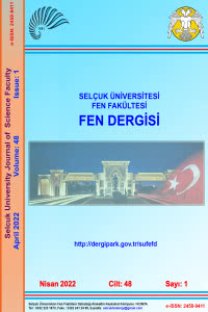Normalize Edilmiş Uzaklık Değerleri ile Hızlı K-ortalama Renkli Görüntü Segmentasyonu
FAST K-MEANS COLOR IMAGE CLUSTERING WITH NORMALIZED DISTANCE VALUES
___
- de Amorim, R.C., Makarenkov, V., 2016, "Applying Subclustering and Lp Distance in Weighted KMeans with Distributed Centroids", Neurocomputing, Vol. 173, pp. 700–707.
- Axelsson, P., 2000, "DEM Generation from Laser Scanner Data Using adaptive TIN Models", International Archives of Photogrammetry and Remote Sensing, Vol. 33(Part B4), pp.110–117.
- Cheng, H.D., Jiang, X. H., Sun, Y., Wang, J., 2001, "Color Image Segmentation: Advances and Prospects", Pattern Recognition, Vol. 34(12), pp.2259–2281.
- Dai, S., Lu, K., Dong, J., Zhang, Y., Chen, Y., 2015, "A Novel Approach of Lung Segmentation on chest CT Images using Graph Cuts", Neurocomputing, Vol. 168, pp.799–807.
- Felzenszwalb, P.F., Huttenlocher, D.P., 2004, "Efficient Graph-Based Image Segmentation", International Journal of Computer Vision, Vol. 59(2), pp.167–181.
- Gingles, C., Celebi, M.E., 2014, "Histogram-Based Method for Effective Initialization of the K-Means Clustering Algorithm", The Twenty-Seventh International Flairs Conference In FLAIRS Conference, Florida, 21-23 May 2014.
- Gonzalez, R.C., Woods, R.E., 2007, Digital Image Processing (3rd Edition), Pearson International Edition.
- Jain, A.K., 2010, "Data Clustering: 50 Years Beyond K-means", Pattern Recognition Letters, Vol. 31(8), pp.651–666.
- Jain, A.K., Dubes, R.C., 1988, Algorithms for Clustering Data, Prentice Hall, 355, p.320.
- Jain, A.K., Murty, M.N., Flynn, P.J., 1999, "Data Clustering: a Review", ACM Computing Surveys, Vol. 31(3), pp.264–323.
- Labeling, S., Vaihingen, B., 2016, Use of the Stair Vision Library within the ISPRS Use of the Stair Vision Library within the ISPRS 2D,
- Likas, A., Vlassis, N., J. Verbeek, J., 2003, "The Global k-means Clustering Algorithm", Pattern Recognition, Vol. 36(2), pp.451–461.
- Lin, C.-H., Chen, C. C., Lee, H. L., Liao, J. R., 2014, "Fast K-means Algorithm Based on a Level Histogram for Image Retrieval", Expert Systems with Applications, Vol. 41(7), pp.3276–3283.
- Lloyd, S.P., 1982, "Least Squares Quantization in PCM", IEEE Transactions on Information Theory, Vol. 28(2), pp.129–137.
- Mignotte, M., 2008, "Segmentation by Fusion of Histogram-Based K-means Clusters in Different Color Spaces", IEEE Transactions on Image Processing, Vol. 17(5), pp.780–787.
- Peng, B., Zhang, L., Zhang, D., 2013, "A survey of Graph Theoretical Approaches to Image Segmentation", Pattern Recognition, Vol. 46(3), pp.1020–1038.
- Punjab, P., Punjab, P., 2012, "Performance Analysis of Segmentation Techniques", International Journal of Computer Applications, Vol. 45(23), pp.18–23.
- Rupali, N., Shweta, J., 2014, "Color Image Segmentation With K Means", Saiom publications, Vol. 1(5), pp.389–397. Available at:
- Saglam, A., Baykan, N.A., 2017, "Sequential Image Segmentation Based on Minimum Spanning Tree Representation", Pattern Recognition Letters, Vol. 87, pp.155–162.
- Tian, M., Yang, Q., Maier, A., Schasiepen, I., Maass, N., Elter, M., 2013, "Automatic Histogram-Based Initialization of K-means Clustering in CT". In Bildverarbeitung für die Medizin 2013, Springer Berlin Heidelberg, pp. 277–282.
- ISSN: 2147-9364
- Yayın Aralığı: 2
- Başlangıç: 2013
- Yayıncı: Selçuk Üniversitesi Mühendislik Fakültesi
MEGA ŞEHİR İSTANBUL'UN FIRTINALARININ ARAŞTIRILMASI
Emrah Tuncay ÖZDEMİR, Emrah Tuncay ÖZDEMİR
PVP-AŞILANMIŞ NiFe2O4 NANO PARÇACIKLARININ YÜZEY POLİMERİZASYONU TEKNİĞİ İLE SENTEZİ
SEMA VURAL, Aysel ALPHAN, SÜLEYMAN KÖYTEPE, TURGAY SEÇKİN
Rüştü AKAY, Memduh SUVEREN, Muzaffer KANAAN
Normalize Edilmiş Uzaklık Değerleri ile Hızlı K-ortalama Renkli Görüntü Segmentasyonu
Ali SAĞLAM, Nurdan AKHAN BAYKAN
METİLEN MAVİSİNİN MAGNETİK NiFe2O4/AKTİF KARBON NANOKOMPOZİTİ İLE ADSORPSİYONU: KİNETİK VE İZOTERM
AYHAN ABDULLAH CEYHAN, ORHAN BAYTAR
SARNIÇ KÖY (HAVRAN/BALIKESİR) ÇEVRESİNDEKİ ANDEZİTLERİN AYRIŞMA BOZUNMA AÇISINDAN İNCELENMESİ
